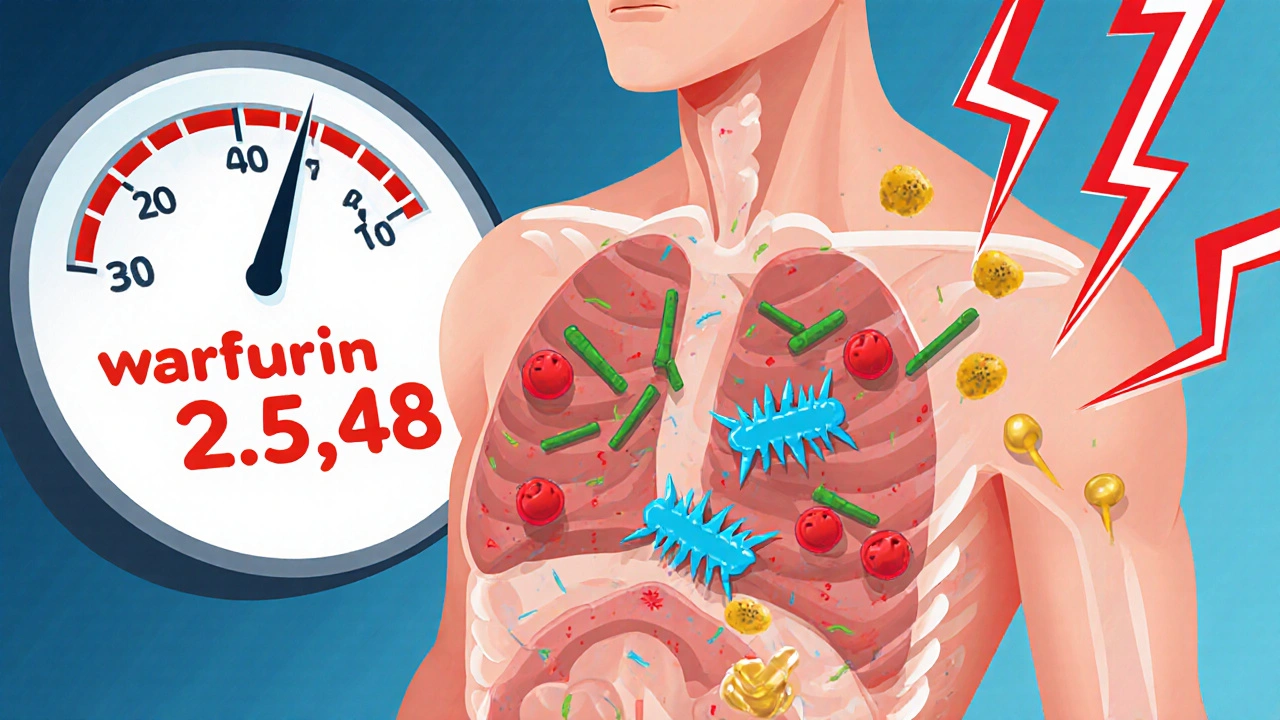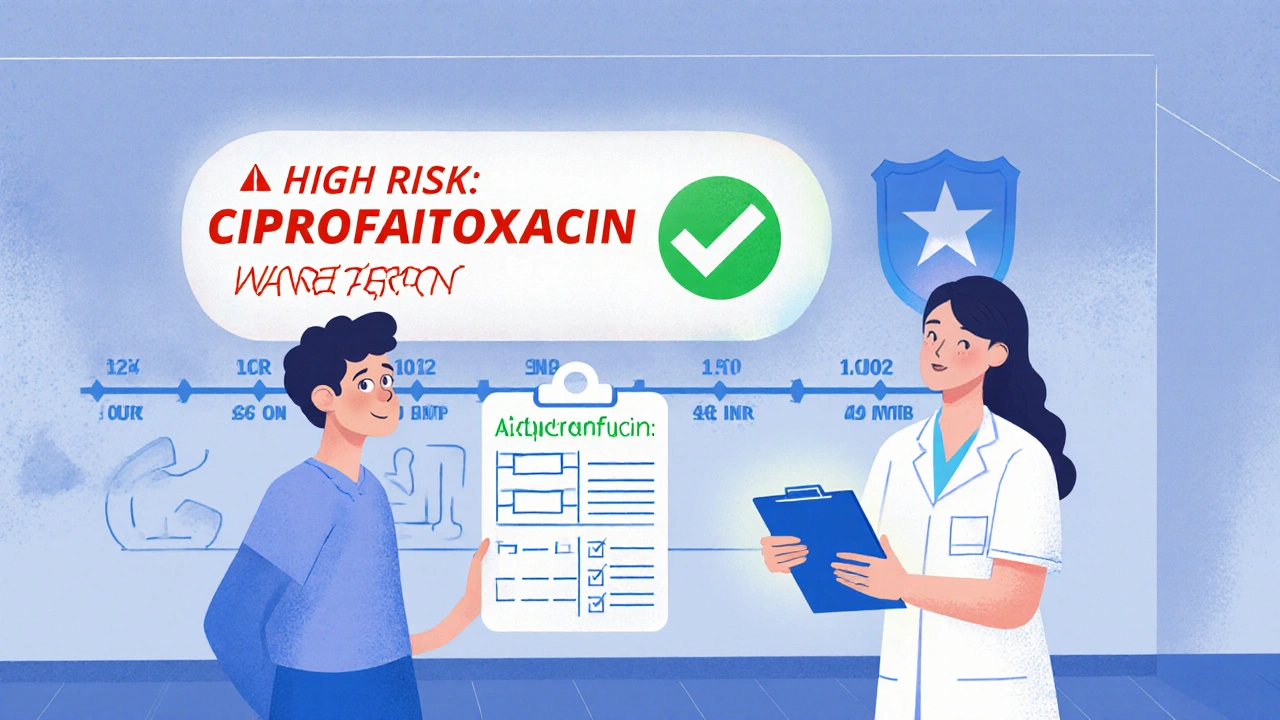
- by Colin Edward Egan
- on 23 Nov, 2025
Antibiotic-Warfarin Interaction Checker
When you're on warfarin, even a simple antibiotic can send your INR through the roof - and put you at serious risk of internal bleeding. This isn't theoretical. In the U.S., nearly half of all warfarin-related emergency visits involve someone who just started an antibiotic. The problem isn't rare. It's predictable. And it's preventable.
Why Antibiotics Mess With Warfarin
Warfarin works by blocking vitamin K, which your body needs to make clotting factors. But your gut bacteria also make about 10-15% of your vitamin K. When antibiotics kill off those bacteria - especially broad-spectrum ones like amoxicillin/clavulanate or cephalosporins - your vitamin K drops. That means warfarin becomes stronger, and your INR climbs. There’s another layer: your liver. Warfarin is broken down by enzymes, mainly CYP2C9. Some antibiotics block that enzyme, making warfarin stick around longer in your blood. Fluoroquinolones like ciprofloxacin and macrolides like erythromycin are major offenders. They don’t just raise your INR - they can spike it from 2.5 to over 4.0 in less than a week.Not All Antibiotics Are Equal
Some antibiotics are low risk. Others are landmines. Here’s what actually matters:- High risk: Ciprofloxacin, levofloxacin, erythromycin, Bactrim (sulfamethoxazole/trimethoprim), amoxicillin/clavulanate, cefotetan, cefoperazone
- Moderate risk: Azithromycin (much safer than erythromycin), doxycycline
- Low risk: Ceftriaxone, nitrofurantoin, fosfomycin, tedizolid
- Reverse effect: Rifampin - this one makes warfarin weaker. Your INR can crash below 1.5, increasing stroke risk.
When INR Goes Too High
Your target INR is usually between 2.0 and 3.0. If you’re on warfarin for a mechanical heart valve, it might be 2.5 to 3.5. Anything above 4.0 is dangerous. At that level, your risk of major bleeding - like a brain bleed or gastrointestinal hemorrhage - jumps four to eight times. Data from the Journal of Clinical Pharmacology shows that INR over 4.0 leads to hospitalization in 15-30% of cases involving antibiotics. And it’s not just about the number. Bleeding often happens quietly: unexplained bruising, blood in urine or stool, nosebleeds that won’t stop, or headaches that feel different. These aren’t normal. They’re red flags.
What to Do When You Need an Antibiotic
If you’re on warfarin and your doctor prescribes an antibiotic, don’t wait. Here’s your action plan:- Ask: Is this antibiotic necessary? Sometimes, a less risky option exists. For a urinary tract infection, nitrofurantoin or fosfomycin are safer than Bactrim.
- Check your INR before starting. Get a baseline reading. This tells you where you started.
- Get your INR tested within 72 hours of starting the antibiotic. Don’t wait a week. CYP enzyme effects hit fast. Gut flora effects take longer, but you need to catch both.
- Test again weekly until the antibiotic is done - and for a week after. Vitamin K depletion lingers. Your INR can keep rising even after you stop the antibiotic.
- Don’t adjust your warfarin dose on your own. Your provider may reduce your dose by 20-30% for high-risk antibiotics like ciprofloxacin or Bactrim. For rifampin, they may need to increase it.
What Hospitals and Clinics Are Doing Now
Leading anticoagulation clinics follow strict protocols. The American College of Chest Physicians says: test within 72 hours of starting, then twice a week. They also recommend testing again within 72 hours after stopping the antibiotic. Electronic alerts in hospitals help - but only if they’re paired with clinical guidance. A 2019 study showed that alerts alone cut adverse events by just 7%. But when they triggered a pharmacist to call the patient? That number jumped to 22%. In Boston, many clinics now use pharmacist-led anticoagulation teams. They call patients on day 2 and day 5 of antibiotic therapy. They adjust doses based on real-time INR results. They know the difference between ceftriaxone and cefotetan. That kind of attention saves lives.
What You Can Do Today
You don’t need to wait for a hospital visit to stay safe.- Keep a log. Write down every antibiotic you take, the date, your INR before and after.
- Know your symptoms. Unusual bruising? Blood in urine? A headache that won’t go away? Call your clinic immediately.
- Ask your pharmacist. They see your full med list. They know which antibiotics are dangerous with warfarin.
- Don’t assume "natural" means safe. Vitamin K supplements can help reverse high INR - but only under medical supervision. Taking them on your own can undo your treatment.
The Future: Personalized Warfarin Care
Genetics are starting to play a role. People with CYP2C9*2 or *3 variants have a 2.4 times higher chance of dangerous INR spikes when on antibiotics. Testing for these variants isn’t routine yet - but it’s coming. The 2023 WARF-GEN trial showed that using genetic data to adjust warfarin doses before starting antibiotics cut INR instability by 41%. That’s huge. It means we’re moving from guesswork to precision. For now, the best tool you have is awareness. Know your meds. Know your INR. Know your symptoms. And don’t be afraid to speak up - especially when a new antibiotic is added to your list.Warfarin isn’t a drug you take and forget. It’s a partnership - between you, your doctor, your pharmacist, and your body. When antibiotics enter the picture, that partnership needs to get even tighter.
Can I take amoxicillin while on warfarin?
Amoxicillin alone is low risk, but amoxicillin/clavulanate (Augmentin) can raise your INR by about 1.2 units on average. This is because clavulanate disrupts gut bacteria that make vitamin K. Get your INR checked within 72 hours of starting it, and again a week later. Don’t stop your warfarin - just monitor closely.
Does azithromycin affect INR like erythromycin?
No. Azithromycin has minimal effect on CYP enzymes and doesn’t significantly raise INR. Studies show only a 1.2-fold increase in bleeding risk, which isn’t statistically significant. Erythromycin, on the other hand, is a strong CYP3A4 inhibitor and can spike INR. If you need a macrolide, azithromycin is the safer choice.
How long after stopping an antibiotic should I keep checking my INR?
For antibiotics that kill gut bacteria - like cephalosporins or amoxicillin/clavulanate - INR can stay elevated for 7 to 10 days after you finish the course. For CYP-inhibiting antibiotics like ciprofloxacin, effects fade within 72 hours of stopping. But because you can’t always know which mechanism is at play, continue checking INR weekly for at least a week after the antibiotic ends.
Can I take vitamin K supplements to lower my INR?
Only under medical supervision. While vitamin K can reverse high INR, taking it without guidance can make your warfarin ineffective. If your INR is above 4.0, your provider may give you a small, controlled dose. Never self-treat with supplements - it can lead to dangerous clots or uncontrolled bleeding.
Why does rifampin lower my INR?
Rifampin is a powerful enzyme inducer. It speeds up how fast your liver breaks down warfarin - by up to 60%. This can cause your INR to drop below 1.5, increasing your risk of stroke or blood clots. If you’re prescribed rifampin, your warfarin dose will likely need to be increased by 50-100%, and your INR must be checked daily until stable.
What should I do if I miss my INR test while on antibiotics?
Call your anticoagulation clinic immediately. Missing a test during antibiotic therapy is risky. Your INR could be dangerously high or low without symptoms. Most clinics will ask you to come in for a stat test. Don’t wait - bleeding or clotting can happen fast.
Are there antibiotics I should avoid completely on warfarin?
Ciprofloxacin, Bactrim, and cefotetan are high-risk and should be avoided if safer alternatives exist. For urinary infections, nitrofurantoin or fosfomycin are preferred. For pneumonia, azithromycin is safer than erythromycin. Always ask: "Is there a lower-risk antibiotic for someone on warfarin?" Your provider should be able to give you options.
